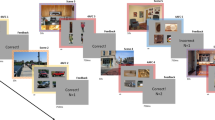Summary
Figural after-effects (FAEs) have been measured in four conditions variing the representational relations between the inspection (I)- and test (T)- figures in respect to the retina and the objective space.
-
1.
The T-figure is exposed to the same retinal region where the previously fixated I-figure has been shown; the positions in objective space of the two figures are different (retinal FAEs).
-
2.
The T-figure lies in the same place in respect to objective space as the I-figure but their retinal positions are different (by change of fixation-mark) (spatial FAEs).
-
3.
T- and I-figures take the same retinal and spatial positions; this is the commonly used FAE-condition (retinal FAEs+spatial FAEs).
-
4.
One of the T-figures lies in the same retinal position as the I-figure, while the other T-figure (comparison-figure) has the same position in objective space as the I-figure (retinal FAEs—spatial FAEs).
FAEs measured under conditions 1 and 2 show that part of the effects can be localized in the retinal coordinates and another part in the coordinates of the head (constancy of direction). The results of these two types of FAEs allowed very good predictions of the magnitude of FAEs under the conditions 3 and 4.
Zusammenfassung
Bei vier Figuralen Nachwirkungs-Anordnungen, die die relativen Abbildungsverhältnisse der sukzessiv gezeigten Inspektions (I)- und Test (T)-Figuren variieren, wurden Figurale Nachwirkungen (FN) gemessen:
-
1.
Die T-Figur wird in dem Netzhautbereich der vorher fixierten I-Figur abgebildet; die objektive Raumlage der beiden Figuren ist verschieden (FN-retinal).
-
2.
Die T-Figur nimmt die gleiche objektive Raumlage wie die I-Figur ein; die retinale Lage der beiden Figuren ist verschieden (Fixationswechsel zwischen I und T-Periode) (FN-Raumlage).
-
3.
T- und I-Figuren nehmen die gleiche objektive Raumlage ein und werden im gleichen Netzhautbereich abgebildet (FN-retinal plus Raumlage, die übliche FN-Anordnung).
-
4.
Die T-Figur fällt in den gleichen Netzhautbereich wie vorher die I-Figur, und die Vergleichsfigur nimmt die gleiche objektive Raumlage wie die I-Figur ein (FN-retinal minus Raumlage).
Unter den beiden ersten Bedingungen lassen sich jeweils FN nachweisen: bei FN gibt es einen Anteil, der in Retina-Koordinaten, und einen der richtungskonstant in Kopfkoordinaten zu lokalisieren ist. Aufgrund der Messung der beiden isolierbaren FN-Arten lassen sich die FN-Beträge unter den beiden Bedingungen 3 und 4 vorhersagen.
Similar content being viewed by others
Literatur
Bischof, N.: Psyohophysik der Raumwahrnehmung. In: Handbuch der Psychologie (W. Metzger, Hrsg.), Bd. I/1. Wahrnehmung und Bewußtsein. Göttingen: Hogrefe 1966.
—, Kramer, E.: Untersuchungen und Überlegungen zur Richtungswahrnehmung bei willkürlichen sakkadischen Augenbewegungen. Psychol. Forsch. 32, 185–218 (1968).
Detering, Erika: Die Abhängigkeit Figuraler Nachwirkungen von der relativen und absoluten Lokalisation. Vordiplomarbeit Münster 1968.
Erke, H.: Größenänderungen optisch wahrgenommener Figuren während der Inspektionszeit. Psychol. Forsch. 31, 63–90 (1967).
—, Schulte, D.: Figur-Auffassung und figurale Nachwirkungen. Psychol. Forsch. 32, 1–13 (1968).
Farnè, M.: Alcune osservazioni con linee virtuali e margini quasi percettivi. Boll. Soc. ital. Biol. sper. 44, 1613–1616 (1968).
- Some observations on Ganz's theory. Psychol. Rev. (in press) (1971).
Ganz, L.: Is the figural aftereffect an aftereffect ? Psychol. Bull. 66, 151–165 (1966).
Gibson, J. J.: Adaptation, after-effect, and contrast in the perception of curved lines. J. exp. Psychol. 16, 1–31 (1933).
—, Radner, M.: Adaptation, after-effect, and contrast in the perception of tilted lines. I. Quantitative studies. J. exp. Psychol. 20, 453–467 (1937).
Hoffmeister, Christl: Messung der Feldstärke von Figuren und Konturen mittels der Methode der Figuralen Nachwirkungen. Vordiplomarbeit Münster 1968.
Immergluck, L.: Further comments on “is the figural aftereffect an aftereffect?”. Psychol. Bull. 70, 198–200 (1968).
Kolehmainen, K.: Studies an apparent properties of inspection objects as determiners of figural after-effects. Turun Yliopisto, Sarja, Ser. B OSA, tom. 119, Turku, Finland 1970.
Mackensen, G.: Elektrische Registrierung von Augenbewegungen. Hausnachrichten. München: Schwarzer GmbH 1957.
Malhotra, M. K.: Figurale Nachwirkungen. Sammelbericht. Psychol. Forsch. 30, 1–104 (1966).
Motokawa, K., Nakagawa, D., Kohata, T.: Figural after-effects and retinal induction. J. gen. Psychol. 57, 121–135 (1957).
Myers, J. L.: Fundamentals of Experimental Design. Boston: Allyn & Bacon 1966.
Piaget, J., Lambercier, M.: Le problème de la comparaison visuelle en profondeur (constance de la grandeur) et e'erreur systématique de l'étalon. Arch. Psychol. 29, 255–308 (1943).
Pollack, R. H.: Comment on “is the figural aftereffect an aftereffect?”. Psychol. Bull. 68, 59–61 (1967).
Sagara, M., Oyama, T.: Experimental studies on figural aftereffects in Japan. Psychol. Bull., 54, 327–338 (1957).
Stadler, M.: Veränderungen der Inspektionsfigur bei Figuralen Nachwirkungen. Vordiplomarbeit Münster 1966.
- Funktionelle Grundlagen der Wahrnehmung von Figuren. Diss. Münster 1968.
—: Figurale Nachwirkungen als Methode zur Untersuchung funktionaler Zusammenhänge im Bereich der Figuralwahrnehmung. Stud. psychol. (Bratislava) 11, 23–31 (1969).
- Figural after-effects as optical illusions. A critical evaluation of Ganz's theory and new experimental data. Im Druck (1971).
Stadler, M., Dieker, J.: Margini quasi-percettivi ed after-effects figurali. Riv. Psicol. 63, 95–104 (1969).
- - Untersuchungen zum Problem virtueller Konturen in der visuellen Wahrnehmung. Im Druck (1971).
- Müskens, W.: Ein Indikator für die Bewußtheit visueller Wahrnehmungen. Ber. 27. Kongr. DGP. Im Druck (1971).
Summerfield, A., Miller, K. M.: Visual illusion and figural after-effect, with and without fixation. Quart. J. exp. Psychol. 7, 149–158 (1955).
Weber, Erna: Grundriß der biologischen Statistik. Jena: VEB Gustav Fischer 1964.
Author information
Authors and Affiliations
Additional information
Mit Unterstützung der Deutschen Forschungsgemeinschaft.
Rights and permissions
About this article
Cite this article
Crabus, H., Stadler, M. Über Wahrnehmungsprozesse in den Koordinaten der Netzhaut und des anschaulichen Raumes. Psychol. Forsch. 34, 325–342 (1971). https://doi.org/10.1007/BF00424731
Received:
Issue Date:
DOI: https://doi.org/10.1007/BF00424731




